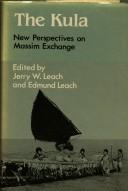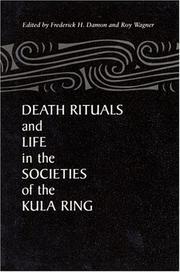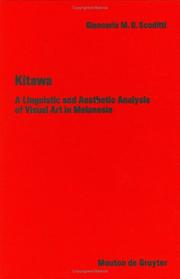| Listing 1 - 10 of 570 | << page >> |
Sort by
|
Book
Year: 2013 Publisher: [Deurne] Edition Kapa
Abstract | Keywords | Export | Availability | Bookmark
 Loading...
Loading...Choose an application
- Reference Manager
- EndNote
- RefWorks (Direct export to RefWorks)
Book
ISBN: 0936127007 Year: 1985 Publisher: Berkeley (Calif.) : Regents of the University of California,
Abstract | Keywords | Export | Availability | Bookmark
 Loading...
Loading...Choose an application
- Reference Manager
- EndNote
- RefWorks (Direct export to RefWorks)
Ethnology --- Kula exchange --- Exhibitions.
Book
ISBN: 9789188539076 9188539075 Year: 2022 Publisher: Stockholm : Trema Förlag,
Abstract | Keywords | Export | Availability | Bookmark
 Loading...
Loading...Choose an application
- Reference Manager
- EndNote
- RefWorks (Direct export to RefWorks)
Manthey Kula was founded in 2004 by architects Beate Hølmebakk and Per Tamsen. The office works at the intersection of architecture, landscape architecture and art, paying special attention to site, form and narrative. Projects by Manthey Kula have been nominated for the Mies van der Rohe Award in 2009, 2011, 2019 and 2022. Two large paper works have been acquired by major international architectural collections. Rotunda is a book series produces by Trema Förlag. It focuses on contemporary architecture from Scandinavia (Sweden, Norway and Denmark). Each book in the series focuses on one single office or architect, showcasing a selection of their projects as well as interviewing them to try and find the reasons behind their work and their ethos.
72.07 --- Manthey Kula Architects --- Hølmebakk, Beate --- Tamsen, Per --- Architecten. Stedenbouwkundigen A - Z --- Architectural firms --- Agences d'architecture --- Manthey Kula.
Book
ISBN: 0816511918 Year: 1990 Publisher: Tucson (Ariz.) : University of Arizona press,
Abstract | Keywords | Export | Availability | Bookmark
 Loading...
Loading...Choose an application
- Reference Manager
- EndNote
- RefWorks (Direct export to RefWorks)
Kula exchange. --- Massim (Papua New Guinean people) --- Social structure --- Social life and customs.

ISBN: 0521232023 Year: 1983 Publisher: Cambridge,New York : Cambridge University Press,
Abstract | Keywords | Export | Availability | Bookmark
 Loading...
Loading...Choose an application
- Reference Manager
- EndNote
- RefWorks (Direct export to RefWorks)
Kula exchange --- Massim (Papua New Guinean people) --- Economic anthropology --- Congresses --- Congresses.

ISBN: 087580151X 0875805469 Year: 1989 Publisher: DeKalb : Northern Illinois University Press,
Abstract | Keywords | Export | Availability | Bookmark
 Loading...
Loading...Choose an application
- Reference Manager
- EndNote
- RefWorks (Direct export to RefWorks)
Massim (Papua New Guinean people) --- Kula exchange --- Funeral rites and ceremonies --- Massim (Peuple de Papouasie-Nouvelle-Guinée) --- Kula --- Funérailles --- Funeral customs and rites. --- Rites et cérémonies funéraires --- Rites et cérémonies --- Milne Bay Province (Papua New Guinea) --- Milne Bay (Papouasie-Nouvelle-Guinée) --- Social life and customs --- Moeurs et coutumes

ISBN: 1859735134 1859735185 Year: 2002 Publisher: Oxford : Berg,
Abstract | Keywords | Export | Availability | Bookmark
 Loading...
Loading...Choose an application
- Reference Manager
- EndNote
- RefWorks (Direct export to RefWorks)
Ethnology --- Kula exchange. --- Wood-carving, Papuan --- Sex role --- Anthropologie sociale et culturelle --- Kula --- Sculpture sur bois papoue --- Rôle selon le sexe --- Trobriand Islands (Papua New Guinea) --- Trobriand, îles (Papouasie-Nouvelle-Guinée) --- Social life and customs. --- Moeurs et coutumes --- #SBIB:39A5 --- #SBIB:39A10 --- #SBIB:39A76 --- Kunst, habitat, materiële cultuur en ontspanning --- Antropologie: religie, riten, magie, hekserij --- Etnografie: Oceanië --- Rôle selon le sexe --- Trobriand, îles (Papouasie-Nouvelle-Guinée)
Book
ISBN: 9780253015297 0253015294 9780253015235 0253015235 Year: 2015 Publisher: Bloomington
Abstract | Keywords | Export | Availability | Bookmark
 Loading...
Loading...Choose an application
- Reference Manager
- EndNote
- RefWorks (Direct export to RefWorks)
Adil Hussain Khan traces the origins of Ahmadi Islam from a small Sufi-style brotherhood to a major transnational organization, which many Muslims believe to be beyond the pale of Islam.
Sufism --- Religious minorities --- Religion and politics --- Islam and politics --- Ahmadiyya --- Aḥmedīya --- Qadiani --- Qadiyani --- Islamic sects --- Islam --- Politics and Islam --- Political science --- Politics, Practical --- Politics and religion --- Religion --- Religions --- Minorities --- Sofism --- Mysticism --- Missions --- Political aspects --- Religious aspects --- Aḥmad, G̲h̲ulām, --- Ahmad, Ghulam, --- K̇adiānī, G̲h̲ulām Ahmad, --- Aḥmad Khān, G̲h̲ulām, --- Khān, G̲h̲ulam Aḥmad, --- G̲h̲ulām Aḥmad Khān, --- G̲h̲ulām Aḥmad, Mirzā, --- Ahmed, Mirza Ghulam, --- Ahmad de Qadian, --- Ahmad of Qadian, --- Ahmed, Ghulam, --- Qādiyānī, G̲h̲ulām Aḥmad, --- Ahmad, Mirza Ghulam, --- Mirza Ghulam Ahmad, --- Aḥmad, Gulam, --- אחמד, מירזא גולאם, --- ،أحمد، غلام, --- ،غلام احمد, --- ،مرزا غلام احمد, --- ،مرزا غلام احمد قاديانى, --- قاديانى، غلام احمد،, --- قاديانى، مرزا غلام احمد،, --- احمد قاديانى، مرزا غلام،, --- Mirsā Kulām Ahmat Cāhip Kātiyān̲i, --- Kātiyān̲i, Mirsā Kulām Ahmat Cāhip, --- Ahmat Cāhip Kātiyān̲i, Mirsā Kulām, --- Cāhip, Mirsā Kulām Ahmat Kātiyān̲i, --- Sāhib, Mirsā Kulām Ahmat Kātiyān̲i, --- Ahmad von Qadian, --- Aḥmad Qādyānī, Mirzā G̲h̲ulām, --- Qadiani, Mirza Ghulam Ahmad, --- Aḥmad, Ḥaḍrat Mirza Ghulam, --- South Asia --- Asia, South --- Asia, Southern --- Indian Sub-continent --- Indian Subcontinent --- Southern Asia --- Orient --- Ethnic relations. --- Politics and government.

ISBN: 3110117665 311086195X 9783110117660 Year: 1990 Volume: 83 Publisher: Berlin New York Mouton de Gruyter
Abstract | Keywords | Export | Availability | Bookmark
 Loading...
Loading...Choose an application
- Reference Manager
- EndNote
- RefWorks (Direct export to RefWorks)
Kitawa --- Kula exchange --- Art, Papua New Guinean --- Art papouan-néo-guinéen --- Kitava (Papua New Guinea) --- Kitava (Papouasie-Nouvelle-Guinée) --- Art papouan-néo-guinéen --- Kitava (Papouasie-Nouvelle-Guinée) --- Art --- Social life and customs --- Moeurs et coutumes --- Ship decoration --- Papua New Guinea --- Canoes and canoeing --- New Caledonia --- Ethnology --- Social life and customs. --- Wood-carving, Papuan --- Kula ring --- Ceremonial exchange --- Massim (Papua New Guinean people) --- Rites and ceremonies --- Papuan wood-carving --- Cultural anthropology --- Ethnography --- Races of man --- Social anthropology --- Anthropology --- Human beings --- Commerce --- Kitawa (Papua New Guinea) --- Marshall Bennett Islands (Papua New Guinea) --- Trobriand Islands (Papua New Guinea)
Book
ISBN: 3030110451 3030110443 Year: 2020 Publisher: Cham : Springer International Publishing : Imprint: Springer,
Abstract | Keywords | Export | Availability | Bookmark
 Loading...
Loading...Choose an application
- Reference Manager
- EndNote
- RefWorks (Direct export to RefWorks)
This book tells the story behind the first Spirodela genome sequencing project. Further, it describes the current genomics applications of these findings, and efforts to sequence new genomes within the family. The closing chapters address the sequencing of the over 1 Gigabase Wolffia genomes, which could have major impacts on genome evolution and agricultural research. The duckweed or Lemnaceae family is a collection of 5 genera and 37 species of the smallest, fastest-growing flowering plants. Many of these aquatic monocotyledonous plants can grow all over the world, in a variety of climates. Given their simplified and neotenous morphology, duckweeds have been researched for several decades as a model species for plant physiology and ecotoxicological research, contributing to our understanding e.g. of flowering response, plant circadian systems, sulfur assimilation pathways and auxin biosynthesis. In addition, duckweed-based treatment has been a favorite and feasible means, especially in developing countries, of removing phosphorus and pharmaceutical chemicals from sewage and wastewater. With a dry annual mass yield per hectare of up to 80 tonnes (equivalent to 10 tonnes of protein), duckweed is also a promising aquatic crop in new modern and sustainable agriculture. Besides being an excellent primary or supplemental feedstock for the production of livestock and fish, duckweed biomass can be utilized as a potential resource for human nutrition, biofuel, or bioplastics, depending on water quality as well as protein or starch accumulating procedures. These academic and commercial interests have led to international efforts to sequence the Spirodela polyrhiza genome, the smallest and most ancient genome in the family.
Plant genetics. --- Plant breeding. --- Agriculture. --- Plant Genetics and Genomics. --- Plant Breeding/Biotechnology. --- Farming --- Husbandry --- Industrial arts --- Life sciences --- Food supply --- Land use, Rural --- Crops --- Agriculture --- Breeding --- Plants --- Genetics --- Plant genomes. --- Portulaca oleracea. --- Akulikuli-kula --- Common purslane --- Duckweed --- Garden purslane --- Hogweed, Little --- Little hogweed --- Portulaca neglecta --- Portulaca retusa --- Purslane --- Pursley --- Pusley --- Wild portulaca --- Portulaca --- Plant genome --- Genomes
| Listing 1 - 10 of 570 | << page >> |
Sort by
|

 Search
Search Feedback
Feedback About UniCat
About UniCat  Help
Help News
News